Foundational Business Maths: NPV, Loan Amortization and OCBC vs DBS
VerifiedAdded on 2023/06/10
|7
|1272
|141
Homework Assignment
AI Summary
This assignment delves into foundational business mathematics, covering loan amortization schedules, net present value (NPV) calculations, and an analysis of the global financial crisis. It compares loan options from OCBC and DBS, evaluating their interest rates and benefits, ultimately recommending OCBC due to its wider range of advantages despite a higher initial payment. The assignment includes detailed NPV calculations for Plant A and Plant B, determining that Plant A should be chosen due to its higher NPV. Furthermore, it analyzes the causes of the global financial crisis, attributing it to the US housing market collapse, subprime mortgages, and the role of asymmetric information in securitized mortgage credit. Desklib offers a wide range of resources, including similar assignments and past papers, to support students in their academic endeavors.
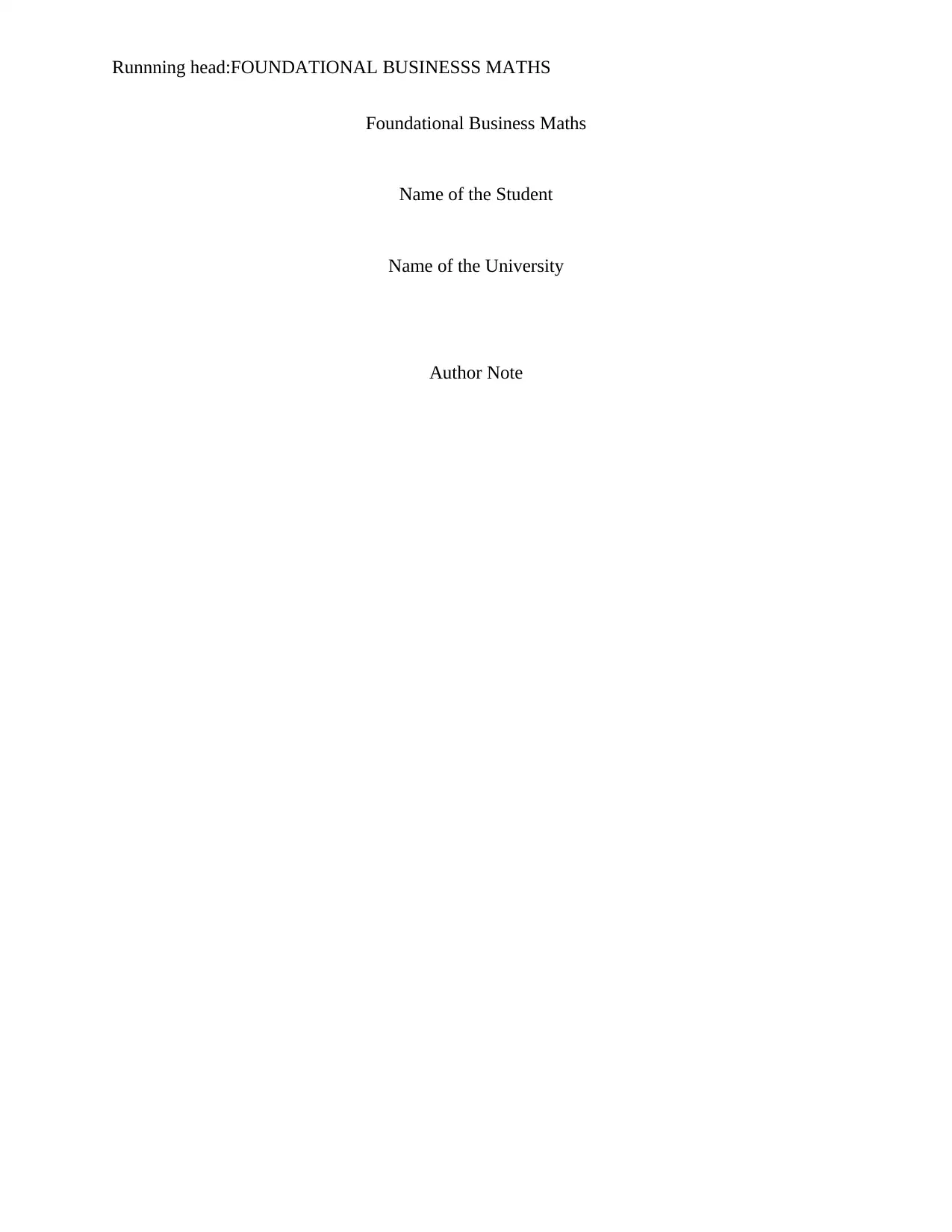
Runnning head:FOUNDATIONAL BUSINESSS MATHS
Foundational Business Maths
Name of the Student
Name of the University
Author Note
Foundational Business Maths
Name of the Student
Name of the University
Author Note
Paraphrase This Document
Need a fresh take? Get an instant paraphrase of this document with our AI Paraphraser
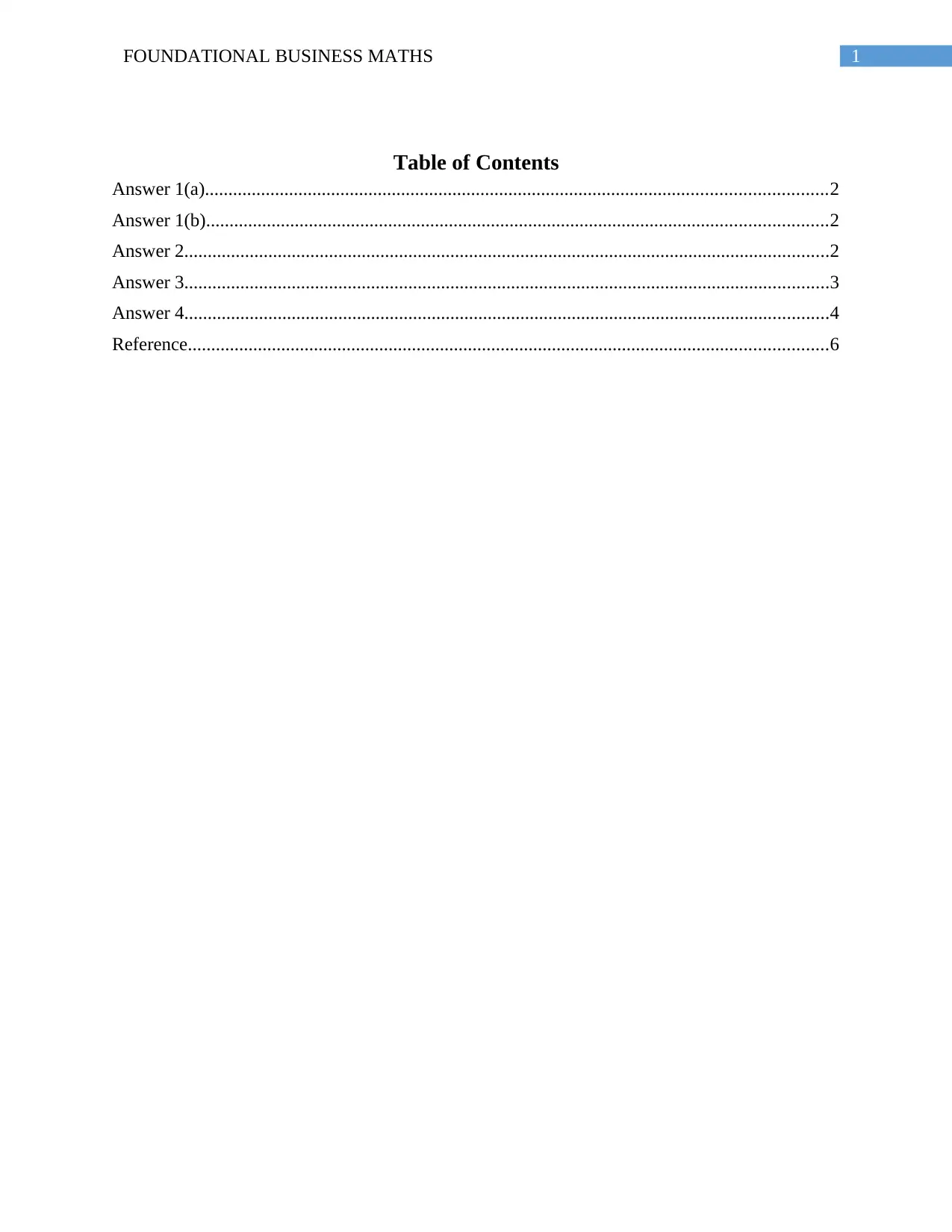
1FOUNDATIONAL BUSINESS MATHS
Table of Contents
Answer 1(a).....................................................................................................................................2
Answer 1(b).....................................................................................................................................2
Answer 2..........................................................................................................................................2
Answer 3..........................................................................................................................................3
Answer 4..........................................................................................................................................4
Reference.........................................................................................................................................6
Table of Contents
Answer 1(a).....................................................................................................................................2
Answer 1(b).....................................................................................................................................2
Answer 2..........................................................................................................................................2
Answer 3..........................................................................................................................................3
Answer 4..........................................................................................................................................4
Reference.........................................................................................................................................6
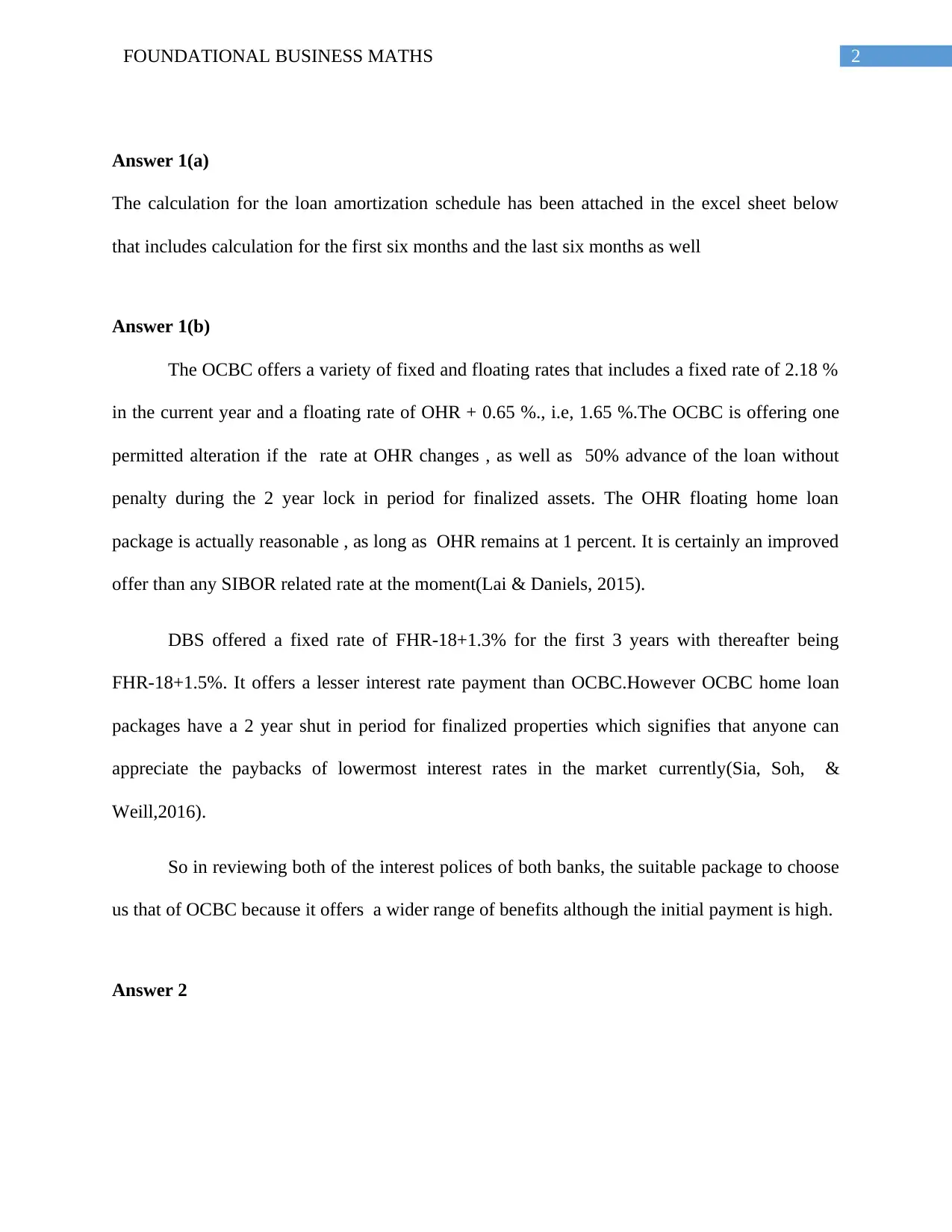
2FOUNDATIONAL BUSINESS MATHS
Answer 1(a)
The calculation for the loan amortization schedule has been attached in the excel sheet below
that includes calculation for the first six months and the last six months as well
Answer 1(b)
The OCBC offers a variety of fixed and floating rates that includes a fixed rate of 2.18 %
in the current year and a floating rate of OHR + 0.65 %., i.e, 1.65 %.The OCBC is offering one
permitted alteration if the rate at OHR changes , as well as 50% advance of the loan without
penalty during the 2 year lock in period for finalized assets. The OHR floating home loan
package is actually reasonable , as long as OHR remains at 1 percent. It is certainly an improved
offer than any SIBOR related rate at the moment(Lai & Daniels, 2015).
DBS offered a fixed rate of FHR-18+1.3% for the first 3 years with thereafter being
FHR-18+1.5%. It offers a lesser interest rate payment than OCBC.However OCBC home loan
packages have a 2 year shut in period for finalized properties which signifies that anyone can
appreciate the paybacks of lowermost interest rates in the market currently(Sia, Soh, &
Weill,2016).
So in reviewing both of the interest polices of both banks, the suitable package to choose
us that of OCBC because it offers a wider range of benefits although the initial payment is high.
Answer 2
Answer 1(a)
The calculation for the loan amortization schedule has been attached in the excel sheet below
that includes calculation for the first six months and the last six months as well
Answer 1(b)
The OCBC offers a variety of fixed and floating rates that includes a fixed rate of 2.18 %
in the current year and a floating rate of OHR + 0.65 %., i.e, 1.65 %.The OCBC is offering one
permitted alteration if the rate at OHR changes , as well as 50% advance of the loan without
penalty during the 2 year lock in period for finalized assets. The OHR floating home loan
package is actually reasonable , as long as OHR remains at 1 percent. It is certainly an improved
offer than any SIBOR related rate at the moment(Lai & Daniels, 2015).
DBS offered a fixed rate of FHR-18+1.3% for the first 3 years with thereafter being
FHR-18+1.5%. It offers a lesser interest rate payment than OCBC.However OCBC home loan
packages have a 2 year shut in period for finalized properties which signifies that anyone can
appreciate the paybacks of lowermost interest rates in the market currently(Sia, Soh, &
Weill,2016).
So in reviewing both of the interest polices of both banks, the suitable package to choose
us that of OCBC because it offers a wider range of benefits although the initial payment is high.
Answer 2
⊘ This is a preview!⊘
Do you want full access?
Subscribe today to unlock all pages.

Trusted by 1+ million students worldwide
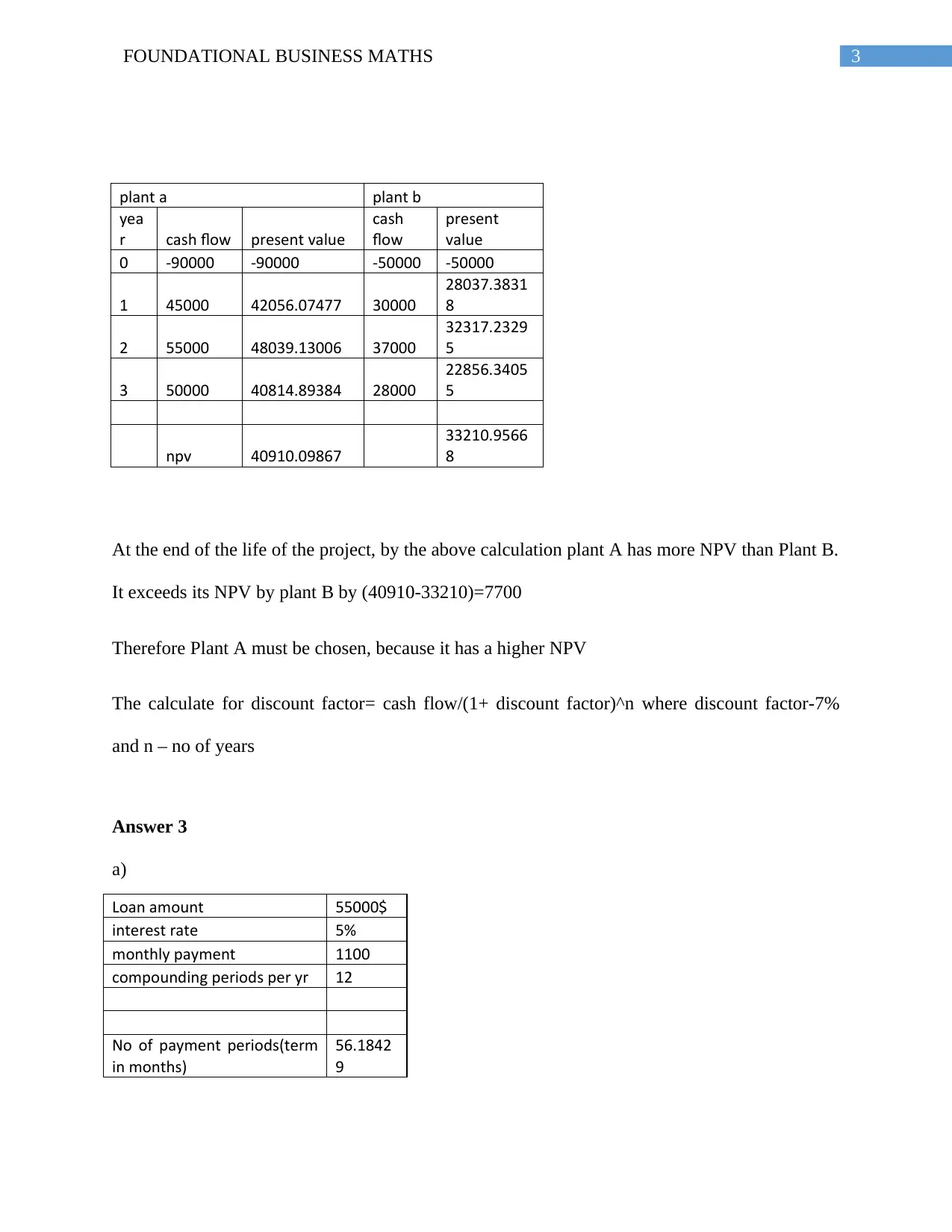
3FOUNDATIONAL BUSINESS MATHS
plant a plant b
yea
r cash flow present value
cash
flow
present
value
0 -90000 -90000 -50000 -50000
1 45000 42056.07477 30000
28037.3831
8
2 55000 48039.13006 37000
32317.2329
5
3 50000 40814.89384 28000
22856.3405
5
npv 40910.09867
33210.9566
8
At the end of the life of the project, by the above calculation plant A has more NPV than Plant B.
It exceeds its NPV by plant B by (40910-33210)=7700
Therefore Plant A must be chosen, because it has a higher NPV
The calculate for discount factor= cash flow/(1+ discount factor)^n where discount factor-7%
and n – no of years
Answer 3
a)
Loan amount 55000$
interest rate 5%
monthly payment 1100
compounding periods per yr 12
No of payment periods(term
in months)
56.1842
9
plant a plant b
yea
r cash flow present value
cash
flow
present
value
0 -90000 -90000 -50000 -50000
1 45000 42056.07477 30000
28037.3831
8
2 55000 48039.13006 37000
32317.2329
5
3 50000 40814.89384 28000
22856.3405
5
npv 40910.09867
33210.9566
8
At the end of the life of the project, by the above calculation plant A has more NPV than Plant B.
It exceeds its NPV by plant B by (40910-33210)=7700
Therefore Plant A must be chosen, because it has a higher NPV
The calculate for discount factor= cash flow/(1+ discount factor)^n where discount factor-7%
and n – no of years
Answer 3
a)
Loan amount 55000$
interest rate 5%
monthly payment 1100
compounding periods per yr 12
No of payment periods(term
in months)
56.1842
9
Paraphrase This Document
Need a fresh take? Get an instant paraphrase of this document with our AI Paraphraser
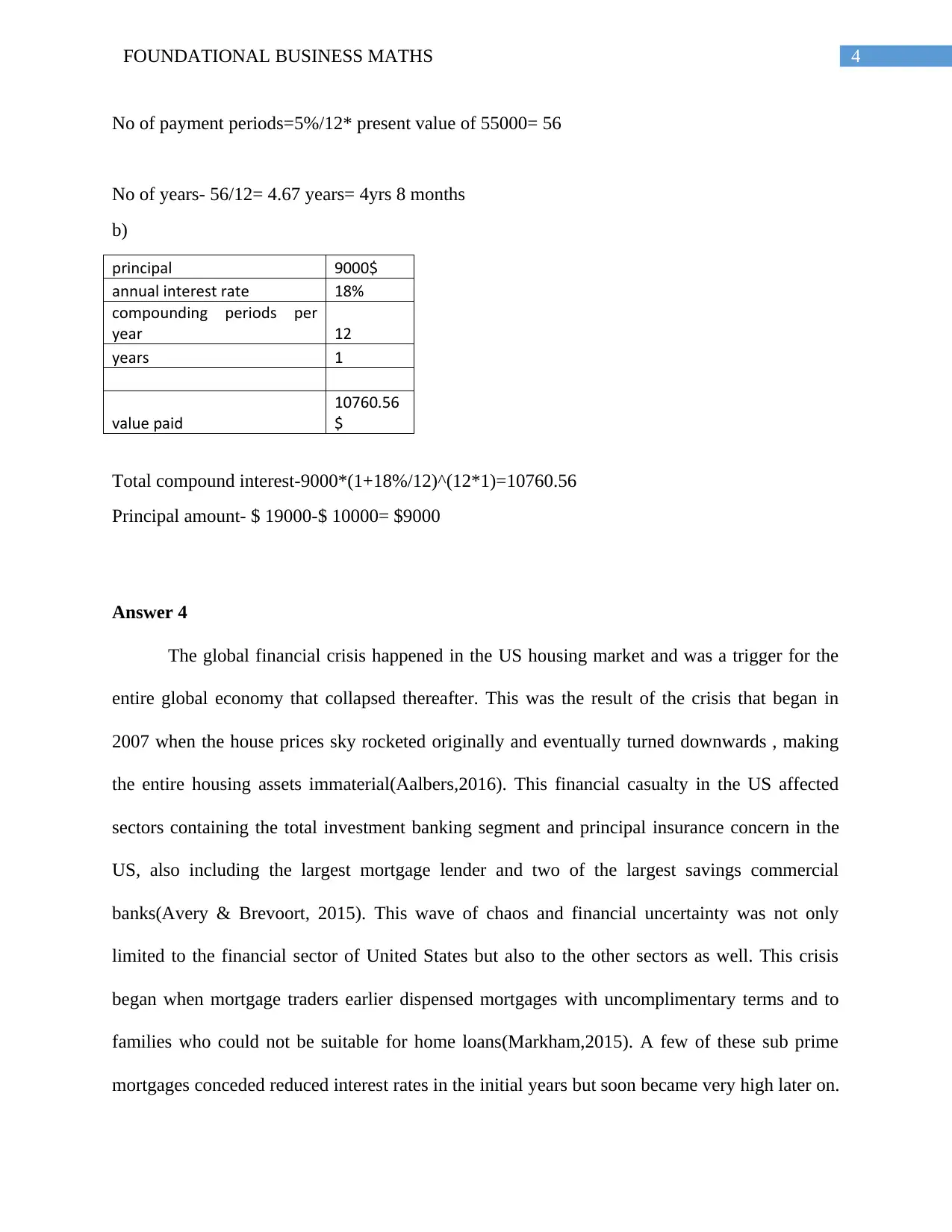
4FOUNDATIONAL BUSINESS MATHS
No of payment periods=5%/12* present value of 55000= 56
No of years- 56/12= 4.67 years= 4yrs 8 months
b)
principal 9000$
annual interest rate 18%
compounding periods per
year 12
years 1
value paid
10760.56
$
Total compound interest-9000*(1+18%/12)^(12*1)=10760.56
Principal amount- $ 19000-$ 10000= $9000
Answer 4
The global financial crisis happened in the US housing market and was a trigger for the
entire global economy that collapsed thereafter. This was the result of the crisis that began in
2007 when the house prices sky rocketed originally and eventually turned downwards , making
the entire housing assets immaterial(Aalbers,2016). This financial casualty in the US affected
sectors containing the total investment banking segment and principal insurance concern in the
US, also including the largest mortgage lender and two of the largest savings commercial
banks(Avery & Brevoort, 2015). This wave of chaos and financial uncertainty was not only
limited to the financial sector of United States but also to the other sectors as well. This crisis
began when mortgage traders earlier dispensed mortgages with uncomplimentary terms and to
families who could not be suitable for home loans(Markham,2015). A few of these sub prime
mortgages conceded reduced interest rates in the initial years but soon became very high later on.
No of payment periods=5%/12* present value of 55000= 56
No of years- 56/12= 4.67 years= 4yrs 8 months
b)
principal 9000$
annual interest rate 18%
compounding periods per
year 12
years 1
value paid
10760.56
$
Total compound interest-9000*(1+18%/12)^(12*1)=10760.56
Principal amount- $ 19000-$ 10000= $9000
Answer 4
The global financial crisis happened in the US housing market and was a trigger for the
entire global economy that collapsed thereafter. This was the result of the crisis that began in
2007 when the house prices sky rocketed originally and eventually turned downwards , making
the entire housing assets immaterial(Aalbers,2016). This financial casualty in the US affected
sectors containing the total investment banking segment and principal insurance concern in the
US, also including the largest mortgage lender and two of the largest savings commercial
banks(Avery & Brevoort, 2015). This wave of chaos and financial uncertainty was not only
limited to the financial sector of United States but also to the other sectors as well. This crisis
began when mortgage traders earlier dispensed mortgages with uncomplimentary terms and to
families who could not be suitable for home loans(Markham,2015). A few of these sub prime
mortgages conceded reduced interest rates in the initial years but soon became very high later on.

5FOUNDATIONAL BUSINESS MATHS
The lenders of these mortgage loans not only kept these loans but also disposed them off to the
big banks like Freddie Mac or Fannie Mae to acquire mortgages and give an oportunity to
mortgage investors to come up with more money for advancing purpose(Holt,2018).There was
an implied understanding that as the prices of housing assets kept rising , everybody turned a
profit and as a result nobody complained. However when the housing bubble burst more and
more, mortgage holders defaulted on their loans. This transpired due to the actions of hedge
resources, banks and insurance corporations. The hedge funds and banks formed mortgage
supported securities, the insurance concerns sheltered them with credit default swaps. This rising
demand for mortgages led to the housing bubble.
In view of the subprime crisis, asymmetric information or failure of delivering
information played a major role.Due to asymmetric information there was an outburst of
securitized mortgage credit , further driving housing prices up(Albertazzi et al., 2016).As a
result of this, securitized mortgage credit did rise up and prices did move higher.Higher housing
prices caused securitized mortgages to become more sensitive to information , meaning that their
level of profit depends less on possibly not verified characteristics like credit scores of borrower
and incomes(Lai & Daniels,2015).Information asymmetry basically implies that higher price
expectations expand credit by lessening the impact of any problems in information inherent in
the process of securitization.
The lenders of these mortgage loans not only kept these loans but also disposed them off to the
big banks like Freddie Mac or Fannie Mae to acquire mortgages and give an oportunity to
mortgage investors to come up with more money for advancing purpose(Holt,2018).There was
an implied understanding that as the prices of housing assets kept rising , everybody turned a
profit and as a result nobody complained. However when the housing bubble burst more and
more, mortgage holders defaulted on their loans. This transpired due to the actions of hedge
resources, banks and insurance corporations. The hedge funds and banks formed mortgage
supported securities, the insurance concerns sheltered them with credit default swaps. This rising
demand for mortgages led to the housing bubble.
In view of the subprime crisis, asymmetric information or failure of delivering
information played a major role.Due to asymmetric information there was an outburst of
securitized mortgage credit , further driving housing prices up(Albertazzi et al., 2016).As a
result of this, securitized mortgage credit did rise up and prices did move higher.Higher housing
prices caused securitized mortgages to become more sensitive to information , meaning that their
level of profit depends less on possibly not verified characteristics like credit scores of borrower
and incomes(Lai & Daniels,2015).Information asymmetry basically implies that higher price
expectations expand credit by lessening the impact of any problems in information inherent in
the process of securitization.
⊘ This is a preview!⊘
Do you want full access?
Subscribe today to unlock all pages.

Trusted by 1+ million students worldwide
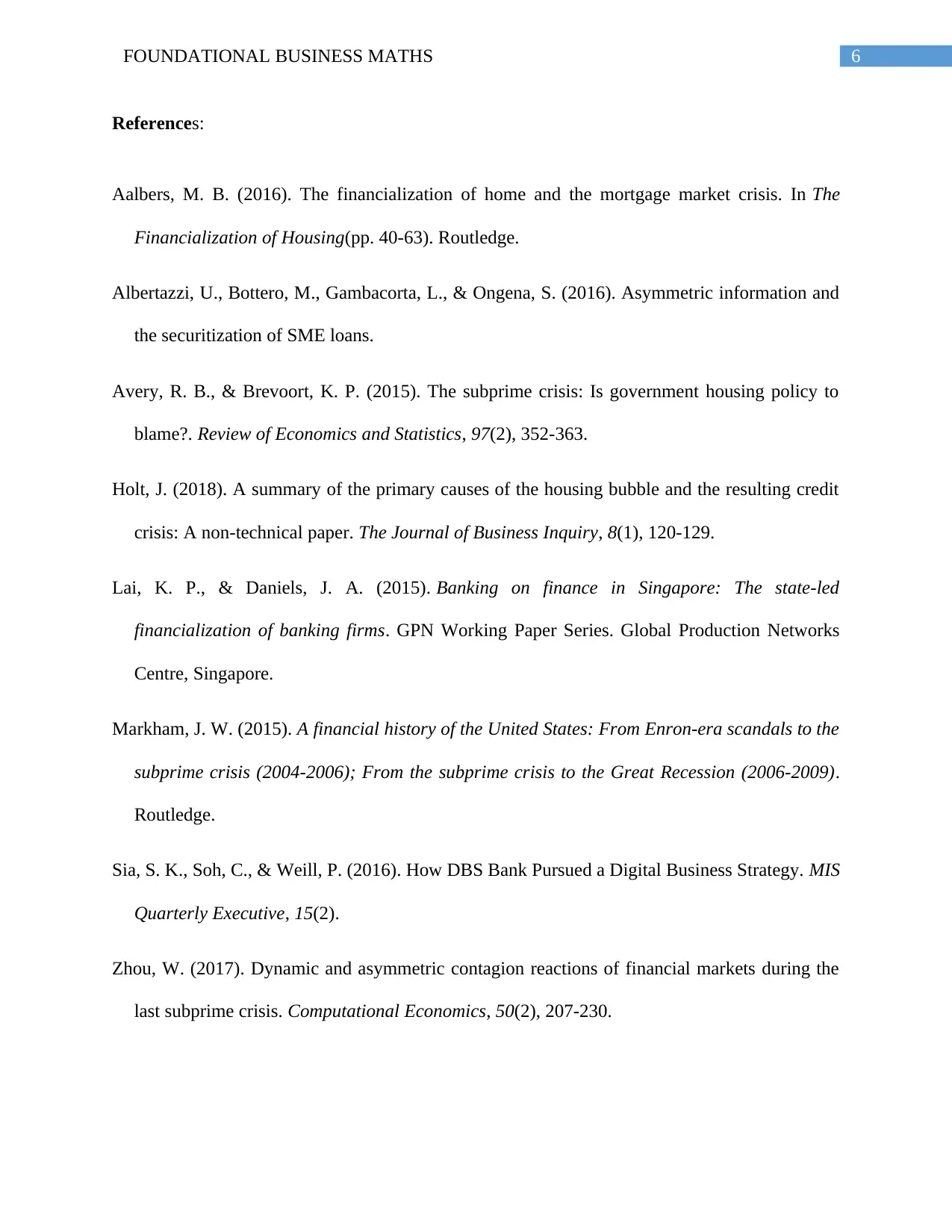
6FOUNDATIONAL BUSINESS MATHS
References:
Aalbers, M. B. (2016). The financialization of home and the mortgage market crisis. In The
Financialization of Housing(pp. 40-63). Routledge.
Albertazzi, U., Bottero, M., Gambacorta, L., & Ongena, S. (2016). Asymmetric information and
the securitization of SME loans.
Avery, R. B., & Brevoort, K. P. (2015). The subprime crisis: Is government housing policy to
blame?. Review of Economics and Statistics, 97(2), 352-363.
Holt, J. (2018). A summary of the primary causes of the housing bubble and the resulting credit
crisis: A non-technical paper. The Journal of Business Inquiry, 8(1), 120-129.
Lai, K. P., & Daniels, J. A. (2015). Banking on finance in Singapore: The state-led
financialization of banking firms. GPN Working Paper Series. Global Production Networks
Centre, Singapore.
Markham, J. W. (2015). A financial history of the United States: From Enron-era scandals to the
subprime crisis (2004-2006); From the subprime crisis to the Great Recession (2006-2009).
Routledge.
Sia, S. K., Soh, C., & Weill, P. (2016). How DBS Bank Pursued a Digital Business Strategy. MIS
Quarterly Executive, 15(2).
Zhou, W. (2017). Dynamic and asymmetric contagion reactions of financial markets during the
last subprime crisis. Computational Economics, 50(2), 207-230.
References:
Aalbers, M. B. (2016). The financialization of home and the mortgage market crisis. In The
Financialization of Housing(pp. 40-63). Routledge.
Albertazzi, U., Bottero, M., Gambacorta, L., & Ongena, S. (2016). Asymmetric information and
the securitization of SME loans.
Avery, R. B., & Brevoort, K. P. (2015). The subprime crisis: Is government housing policy to
blame?. Review of Economics and Statistics, 97(2), 352-363.
Holt, J. (2018). A summary of the primary causes of the housing bubble and the resulting credit
crisis: A non-technical paper. The Journal of Business Inquiry, 8(1), 120-129.
Lai, K. P., & Daniels, J. A. (2015). Banking on finance in Singapore: The state-led
financialization of banking firms. GPN Working Paper Series. Global Production Networks
Centre, Singapore.
Markham, J. W. (2015). A financial history of the United States: From Enron-era scandals to the
subprime crisis (2004-2006); From the subprime crisis to the Great Recession (2006-2009).
Routledge.
Sia, S. K., Soh, C., & Weill, P. (2016). How DBS Bank Pursued a Digital Business Strategy. MIS
Quarterly Executive, 15(2).
Zhou, W. (2017). Dynamic and asymmetric contagion reactions of financial markets during the
last subprime crisis. Computational Economics, 50(2), 207-230.
1 out of 7
Related Documents
Your All-in-One AI-Powered Toolkit for Academic Success.
+13062052269
info@desklib.com
Available 24*7 on WhatsApp / Email
![[object Object]](/_next/static/media/star-bottom.7253800d.svg)
Unlock your academic potential
Copyright © 2020–2025 A2Z Services. All Rights Reserved. Developed and managed by ZUCOL.




